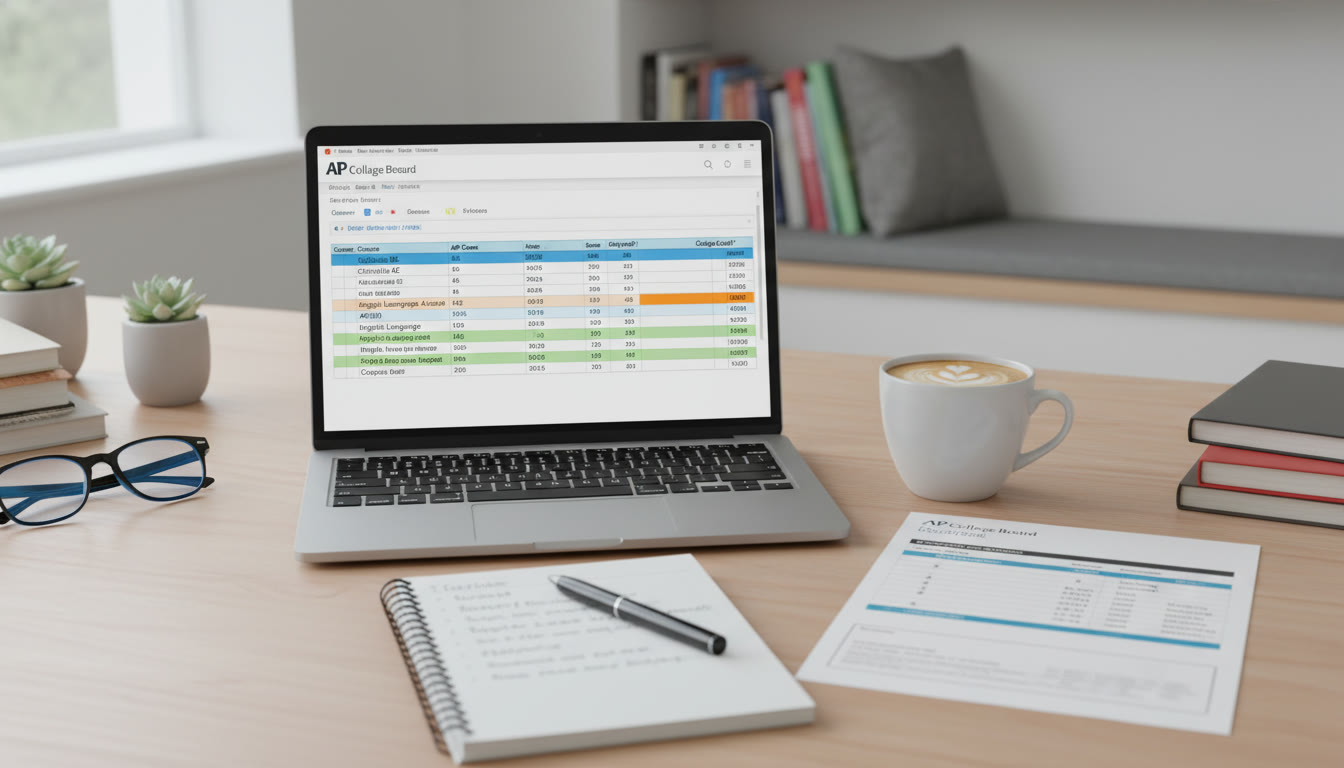Why every AP student needs a Personal AP Credit Dossier
Think of your AP transcript and score history as more than letters and numbers. When organized clearly, they become a strategic asset — a dossier that saves you tuition, opens advanced course options, and lets you design a college roadmap that matches your ambitions. Whether you’re a rising junior mapping AP exams for the next two years, a senior deciding which scores to send, or a parent helping your child navigate choices, a clean, living dossier turns chaos into clarity.

What a dossier does for you
A Personal AP Credit Dossier helps you:
- Track every AP exam you’ve taken and the official scores you received.
- Map those scores to the specific credit or placement policies of the colleges you’re considering.
- Document communications (emails, phone notes) with college registrars and admissions offices.
- Store supporting artifacts — course descriptions, syllabi, or sample AP work — to back up credit appeals or placement requests.
- Plan which scores to send (and when) so you don’t waste your free score send or miss deadlines.
How to structure your dossier: two parts — Spreadsheet + Docs folder
Keep things modular but linked. The spreadsheet is your master-control panel. The Docs folder (cloud or local) stores evidence, written notes, and templates you’ll reuse. Together they do the heavy lifting.
The Spreadsheet: your living command center
Set up a single workbook with multiple sheets. Keep the file name simple and date-version it (for example: AP-Credit-Dossier_2025-10-01.xlsx). Below are recommended sheets and the core columns you’ll want.
| Sheet Name | Purpose | Essential Columns |
|---|---|---|
| Score Log | Record every AP Exam and official score. | Exam (Subject), Year, Score, Exam Date, Score Report Sent (Y/N), Free Send Used (Y/N), Notes |
| College Policies | Collect each college’s AP credit/placement rules. | College, Program/Major, Min Score for Credit, Credit Type (Credit/Placement/Both), Credits Awarded, Notes, Last Verified Date |
| Score-to-Credit Mapping | Cross-reference scores to what you’d receive at each college. | Exam, Your Score, College, Credit Equivalent, Placement (Course Exempted), Comments |
| Send Plan / Deadlines | Track when and where to send official reports. | Year, Recipient College, Deadline to Receive Scores, Free Send Eligible By, Date Sent, Sending Method, Confirmation # |
| Communications | Record emails, phone calls, and decisions. | Date, College Contact, Method (Email/Phone/Form), Summary, Follow-up Date, Saved Doc Filename |
Why that spreadsheet layout works
This layout turns a scattered set of facts into actionable insights. With a single glance you can see which scores unlock the most credits, which colleges require appeals or additional documentation, and when to trigger a score-send. Use filters and conditional formatting to highlight high-value wins (for example: highlight any line where Score >= College’s Min Score).
Setting up the Docs folder: evidence, templates, and a timeline
Think of the Docs folder as a court file: evidence you can pull up when a college asks for proof. Use a cloud solution so you can share links quickly with admissions or registrars.
Folder structure (recommended)
- 01_Score_Reports — PDFs of official score reports or screenshots of your College Board account.
- 02_Course_Artifacts — syllabi, graded sample work, or teacher letters for AP courses.
- 03_College_Responses — emails from registrars, credit evaluation letters, and placement confirmations.
- 04_Templates — score-send request email, appeal letter template, and phone-call log template.
- 05_Timelines — a simple chronological list of actions (when you sent what and to whom).
What to include for a strong credit appeal or placement request
Many colleges have a formal process, but even when they don’t, well-organized supporting documents make granting credit or placement more likely. Include:
- A copy of your official AP score report.
- AP course syllabus or teacher statement showing the rigor and topics covered.
- Examples of your best AP work (lab reports, essays, projects) — anonymized if necessary.
- A concise cover letter that explains why your score should map to a specific course or credit — one page, focused, and polite.

Practical workflows: how to use the dossier during key moments
Before college applications
Use the dossier to prioritize which AP exams to take based on the colleges you target. If a particular school offers 8 credits for Calculus BC but none for Calculus AB, that shapes your planning. Run a quick “value scan” in your spreadsheet: sort colleges by credit-value-per-exam to identify high-impact exams to prepare for.
When you receive scores
Immediately log scores in the Score Log sheet and update the Score-to-Credit Mapping sheet. Decide if and where to use your free annual score send. Seniors should pay special attention to admissions or scholarship deadlines — add them to the Send Plan sheet and to your calendar.
After you commit to a college
Don’t stop. Confirm the college’s process for AP credit recognition. Some schools require students to self-report, upload documents, or take departmental placement tests. Use the Communications sheet to keep a clear audit trail: who you contacted, when, and what they promised.
Example: A short case study
Meet Priya, a high school senior. She scored a 5 on AP Calculus BC and a 4 on AP Biology. Her top-choice private university awards 8 credits for BC scores of 4 or higher and advanced placement in biology only for scores of 5. Priya’s spreadsheet immediately showed two things: (1) Calculus BC is a guaranteed high-value credit at that university; (2) Biology credit is uncertain and might require an appeal or departmental exam.
Priya used her Docs folder to compile the AP Calculus BC course syllabus and a selection of her graded calculus exams. For biology she requested a short letter from her AP teacher summarizing lab work and the course’s emphasis on experimental design. She logged every email exchange with the registrar and, once admitted, sent the official reports timed to the school’s deadline. The result: Priya walked into college with Calculus credit and a direct path into higher-level math courses — which freed up space for a minor in data science.
Tips, tricks, and time-savers
- Use consistent naming conventions for files (date_college_documenttype, e.g., 2025-06-22_UChicago_CreditEval.pdf).
- Color-code spreadsheet rows: green = credit confirmed, yellow = pending, red = denied or no credit.
- Keep a single source of truth: don’t replicate score logs across multiple files. Your spreadsheet should be that truth.
- Set calendar reminders for score-send deadlines and periodic verification of college policies — many schools update policies periodically.
- Export a PDF “credit summary” from your spreadsheet to hand to advisors or bring to orientation.
Spreadsheet features worth learning
Simple formulas are powerful:
- VLOOKUP or INDEX/MATCH to pull a college’s policy into the Score-to-Credit Mapping sheet.
- Conditional formatting to highlight when your score meets or exceeds a school’s minimum.
- Data validation lists (dropdowns) for consistent entries: College names, Exams, Score values.
- Pivot tables to summarize total potential credits per college — handy when comparing offers.
Common pitfalls and how to avoid them
Assuming all colleges treat AP the same
They don’t. Some grant a flat credit number for a score; others offer placement but no credit. Some award credit only for certain majors. The dossier’s College Policies sheet solves this by capturing school-specific nuance.
Missing deadlines for score sends
College Board gives you one free score send each year but it must be used by the stated deadline; also individual colleges have internal deadlines for receiving AP scores for credit consideration. Track all deadlines in your Send Plan and set calendar alerts well in advance.
Relying solely on the College Board’s general guidance
College Board recommendations are a starting point, but always verify the college’s official policy and, when in doubt, ask the registrar and save the response in your Communications sheet.
How personalized help speeds everything up
Building and maintaining a dossier is manageable, but when you’re juggling classes, exams, and applications, a little expert help is a force multiplier. Personalized tutoring — like Sparkl’s tailored 1-on-1 guidance — can help in three concrete ways:
- Strategic planning: tutors help you prioritize APs that deliver the most college credit value for your target schools.
- High-impact preparation: focused sessions raise your likelihood of hitting threshold scores, especially in high-payoff exams like Calculus BC, Physics C, or Biology.
- Administrative know-how: experts guide you through score-send timing, appeal letters, and which artifacts matter when a department asks for proof.
When Sparkl’s expert tutors work alongside your dossier, they don’t replace it — they sharpen it. You get a personalized study plan and AI-driven insights to spot weak areas, plus human coaching to convert knowledge into performance.
Templates you should create now
Save these as reusable docs in your folder so you aren’t reinventing the wheel during crunch time.
- Score-Send Decision Checklist: quick prompts to decide whether to use a free send or a paid send.
- Registrar Email Template: a polite, 3-paragraph message asking for AP credit policy clarification and required documentation.
- Credit Appeal Letter: one-page persuasive template that cites your AP score, course content, and attached artifacts.
- Phone-Call Log: date, time, contact, summary, and next steps — short and searchable.
Example spreadsheet snapshot (sample data)
| Exam | Your Score | College | Credit Awarded | Placement | Notes |
|---|---|---|---|---|---|
| Calculus BC | 5 | State University | 8 Semester Credits | Place into Math 3 | Policy verified 2025-07-10 |
| Biology | 4 | Private College | No Credit | Possible Placement Exam | Contacted dept 2025-08-02 |
| English Language | 3 | Liberal Arts College | 3 Semester Credits | Course Waived | Uploaded syllabus and essay sample |
Keeping the dossier current: a simple maintenance plan
Set a recurring quarterly review. During that session:
- Verify college policy changes and update the Last Verified Date.
- Re-assess which upcoming exams to prioritize based on your target list.
- Clean up older communications and archive final confirmations into a “Completed” folder.
Final checklist before graduation
- All official score reports sent to your chosen college and confirmed in the Send Plan sheet.
- Copies of emailed confirmations saved in 03_College_Responses.
- If you plan to transfer credits after matriculation, confirm the school’s procedure and deadlines.
- Export a final PDF summary for easy reference during orientation, advising appointments, and registration.
Parting advice: make the dossier part of your academic story
A Personal AP Credit Dossier is not just an administrative file. It’s a narrative tool: it tells colleges, advisors, and — most importantly — you, how the work you did in high school translates into educational opportunities. It preserves wins you earned and gives you leverage to push for fair recognition. The simple combination of a well-organized spreadsheet and a thoughtful Docs folder will pay dividends: fewer administrative headaches, smarter course choices, and more time for the things that matter in college.
If the spreadsheet feels overwhelming, start small: log your scores and the top three colleges you’re considering. Build from there. And if you want fast, focused help turning your dossier into results, personalized tutoring options like Sparkl’s 1-on-1 guidance, tailored study plans, and AI-driven insights can accelerate both learning and the administrative steps that follow.
Ready to start?
Open a new workbook, create the five sheets listed here, and enter the exams you’ve already taken. Even a half-hour of focused setup will save you hours later — and might save thousands of dollars in tuition if it helps you secure credit. Your AP achievements are worth organizing; treat them like the strategic advantage they are.
Good luck — and remember: the dossier grows with you. Update it, protect it, and let it do the heavy lifting while you focus on learning and applying your knowledge where it counts.


















No Comments
Leave a comment Cancel